Page 55 of 351
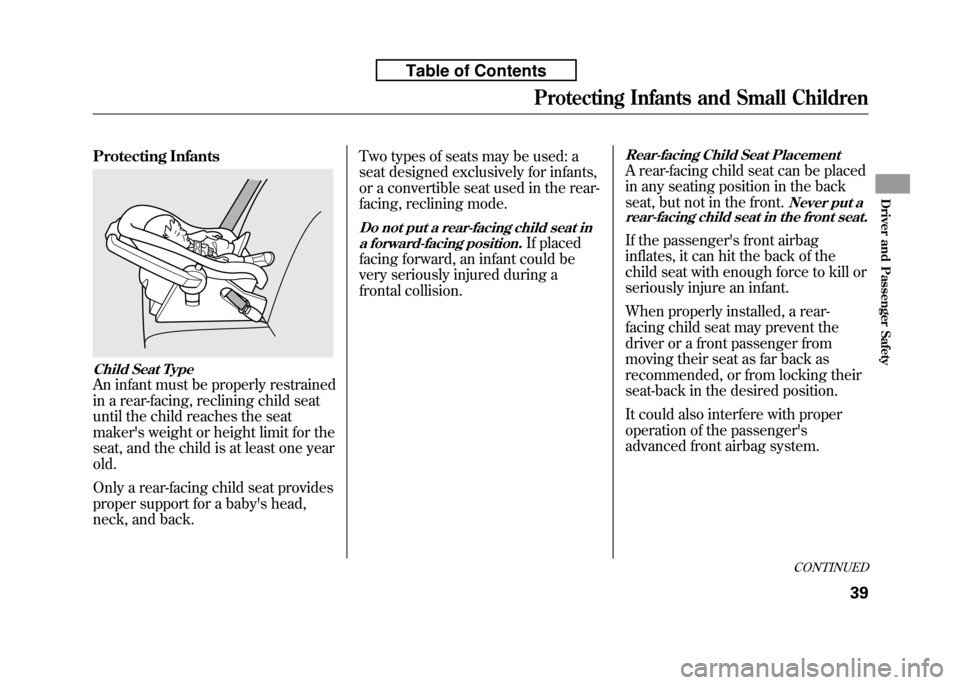
Protecting Infants
Child Seat Type
An infant must be properly restrained
in a rear-facing, reclining child seat
until the child reaches the seat
maker's weight or height limit for the
seat, and the child is at least one yearold.
Only a rear-facing child seat provides
proper support for a baby's head,
neck, and back.Two types of seats may be used: a
seat designed exclusively for infants,
or a convertible seat used in the rear-
facing, reclining mode.
Do not put a rear-facing child seat in
a forward-facing position.
If placed
facing forward, an infant could be
very seriously injured during a
frontal collision.
Rear-facing Child Seat Placement
A rear-facing child seat can be placed
in any seating position in the back
seat, but not in the front.
Never put a
rear-facing child seat in the front seat.
If the passenger's front airbag
inflates, it can hit the back of the
child seat with enough force to kill or
seriously injure an infant.
When properly installed, a rear-
facing child seat may prevent the
driver or a front passenger from
moving their seat as far back as
recommended, or from locking their
seat-back in the desired position.
It could also interfere with proper
operation of the passenger's
advanced front airbag system.
CONTINUED
Protecting Infants and Small Children
39
Driver and Passenger Safety
Table of Contents
Page 56 of 351
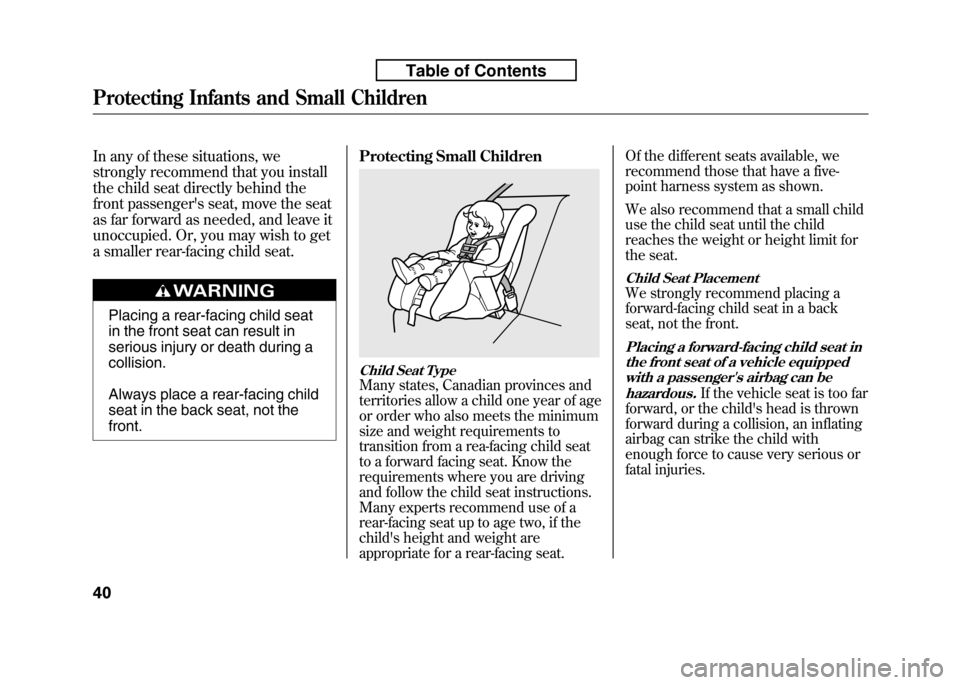
In any of these situations, we
strongly recommend that you install
the child seat directly behind the
front passenger's seat, move the seat
as far forward as needed, and leave it
unoccupied. Or, you may wish to get
a smaller rear-facing child seat.
Placing a rear-facing child seat
in the front seat can result in
serious injury or death during acollision.
Always place a rear-facing child
seat in the back seat, not thefront.Protecting Small Children
Child Seat Type
Many states, Canadian provinces and
territories allow a child one year of age
or order who also meets the minimum
size and weight requirements to
transition from a rea-facing child seat
to a forward facing seat. Know the
requirements where you are driving
and follow the child seat instructions.
Many experts recommend use of a
rear-facing seat up to age two, if the
child's height and weight are
appropriate for a rear-facing seat. Of the different seats available, we
recommend those that have a five-
point harness system as shown.
We also recommend that a small child
use the child seat until the child
reaches the weight or height limit for
the seat.
Child Seat Placement
We strongly recommend placing a
forward-facing child seat in a back
seat, not the front.
Placing a forward-facing child seat in
the front seat of a vehicle equipped
with a passenger's airbag can be
hazardous.
If the vehicle seat is too far
forward, or the child's head is thrown
forward during a collision, an inflating
airbag can strike the child with
enough force to cause very serious or
fatal injuries.
Protecting Infants and Small Children
40
Table of Contents
Page 57 of 351
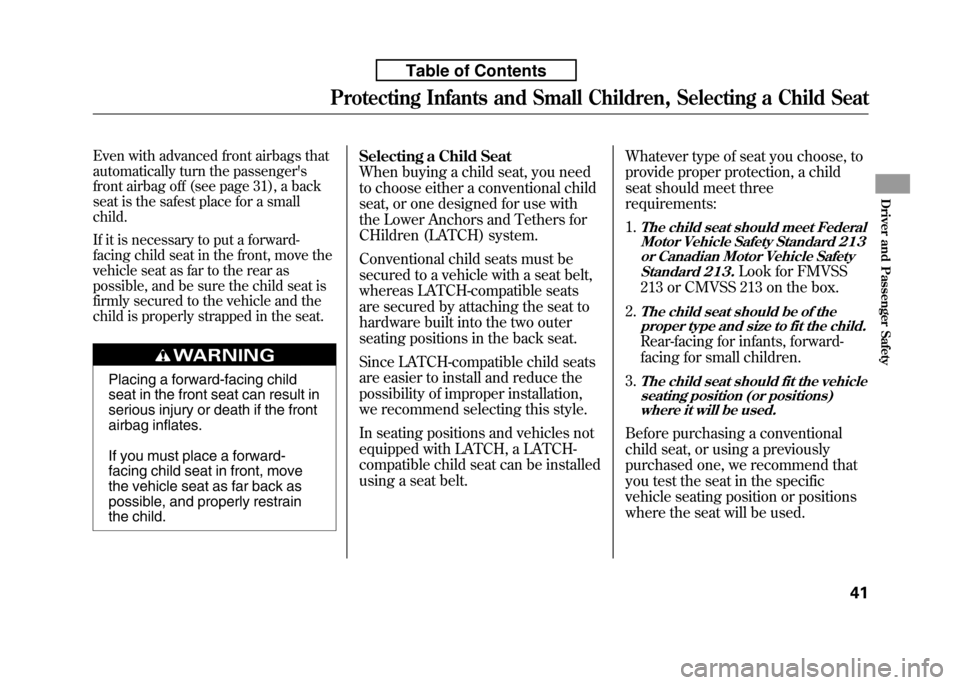
Even with advanced front airbags that
automatically turn the passenger's
front airbag off (see page 31), a back
seat is the safest place for a small child.
If it is necessary to put a forward-
facing child seat in the front, move the
vehicle seat as far to the rear as
possible, and be sure the child seat is
firmly secured to the vehicle and the
child is properly strapped in the seat.
Placing a forward-facing child
seat in the front seat can result in
serious injury or death if the front
airbag inflates.
If you must place a forward-
facing child seat in front, move
the vehicle seat as far back as
possible, and properly restrain
the child.Selecting a Child Seat
When buying a child seat, you need
to choose either a conventional child
seat, or one designed for use with
the Lower Anchors and Tethers for
CHildren (LATCH) system.
Conventional child seats must be
secured to a vehicle with a seat belt,
whereas LATCH-compatible seats
are secured by attaching the seat to
hardware built into the two outer
seating positions in the back seat.
Since LATCH-compatible child seats
are easier to install and reduce the
possibility of improper installation,
we recommend selecting this style.
In seating positions and vehicles not
equipped with LATCH, a LATCH-
compatible child seat can be installed
using a seat belt.
Whatever type of seat you choose, to
provide proper protection, a child
seat should meet threerequirements: 1.
The child seat should meet Federal
Motor Vehicle Safety Standard 213
or Canadian Motor Vehicle Safety
Standard 213.
Look for FMVSS
213 or CMVSS 213 on the box.
2.
The child seat should be of the proper type and size to fit the child.
Rear-facing for infants, forward-
facing for small children.
3.
The child seat should fit the vehicle seating position (or positions)where it will be used.
Before purchasing a conventional
child seat, or using a previously
purchased one, we recommend that
you test the seat in the specific
vehicle seating position or positions
where the seat will be used.
Protecting Infants and Small Children, Selecting a Child Seat
41
Driver and Passenger Safety
Table of Contents
Page 58 of 351
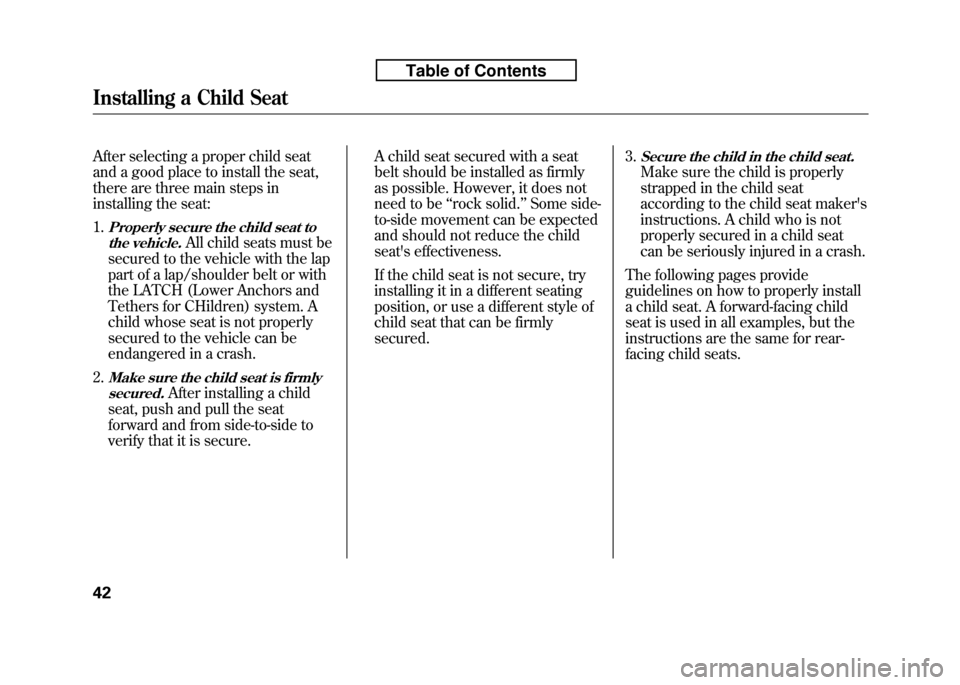
After selecting a proper child seat
and a good place to install the seat,
there are three main steps in
installing the seat: 1.
Properly secure the child seat tothe vehicle.
All child seats must be
secured to the vehicle with the lap
part of a lap/shoulder belt or with
the LATCH (Lower Anchors and
Tethers for CHildren) system. A
child whose seat is not properly
secured to the vehicle can be
endangered in a crash.
2.
Make sure the child seat is firmly secured.
After installing a child
seat, push and pull the seat
forward and from side-to-side to
verify that it is secure. A child seat secured with a seat
belt should be installed as firmly
as possible. However, it does not
need to be
‘‘rock solid. ’’Some side-
to-side movement can be expected
and should not reduce the child
seat's effectiveness.
If the child seat is not secure, try
installing it in a different seating
position, or use a different style of
child seat that can be firmlysecured. 3.
Secure the child in the child seat.
Make sure the child is properly
strapped in the child seat
according to the child seat maker's
instructions. A child who is not
properly secured in a child seat
can be seriously injured in a crash.
The following pages provide
guidelines on how to properly install
a child seat. A forward-facing child
seat is used in all examples, but the
instructions are the same for rear-
facing child seats.
Installing a Child Seat
42
Table of Contents
Page 59 of 351
Installing a Child Seat with LATCH
Your vehicle is equipped with
LATCH (Lower Anchors and Tethers
for CHildren) at the outer rear seats.
The lower anchors are located
between the seat-back and seat
bottom, and are to be used only with
a child seat designed for use withLATCH.
The location of each lower anchor is
indicated by a small button above the
anchor point.
You can find lower anchors in the
slits in the seat-backs.
To install a LATCH-compatible child seat:
1. Move the seat belt buckle ortongue away from the lower anchors.
2. Make sure there are no objects near the anchors that could
prevent a secure connection
between the child seat and the anchors.3. Place the child seat on the vehicleseat, then attach the seat to the
lower anchors according to the
child seat maker's instructions.
Some LATCH-compatible seats
have a rigid-type connector as
shown above.
LOWER ANCHORS
BUTTON
Rigid type
CONTINUED
Installing a Child Seat
43
Driver and Passenger Safety
Table of Contents
Page 60 of 351
Other LATCH-compatible seats
have a flexible-type connector as
shown above.
4. Whatever type you have, follow the child seat maker's instructions for
adjusting or tightening the fit.5. Lift the head restraint (see page94), then route the tether strap
through the legs of the head
restraint and over the seat-back,
making sure the strap is nottwisted.6. Attach the tether strap hook to theanchor, then tighten the strap as
instructed by the child seat maker.
If the tether strap is too long and
cannot be tightened firmly, find a
route where the strap can be
tightened securely.
7. Push and pull the child seat forward and from side-to-side to
verify that it is secure.
Flexible type
ANCHOR
TETHER STRAP HOOK
Installing a Child Seat
44
Table of Contents
Page 61 of 351
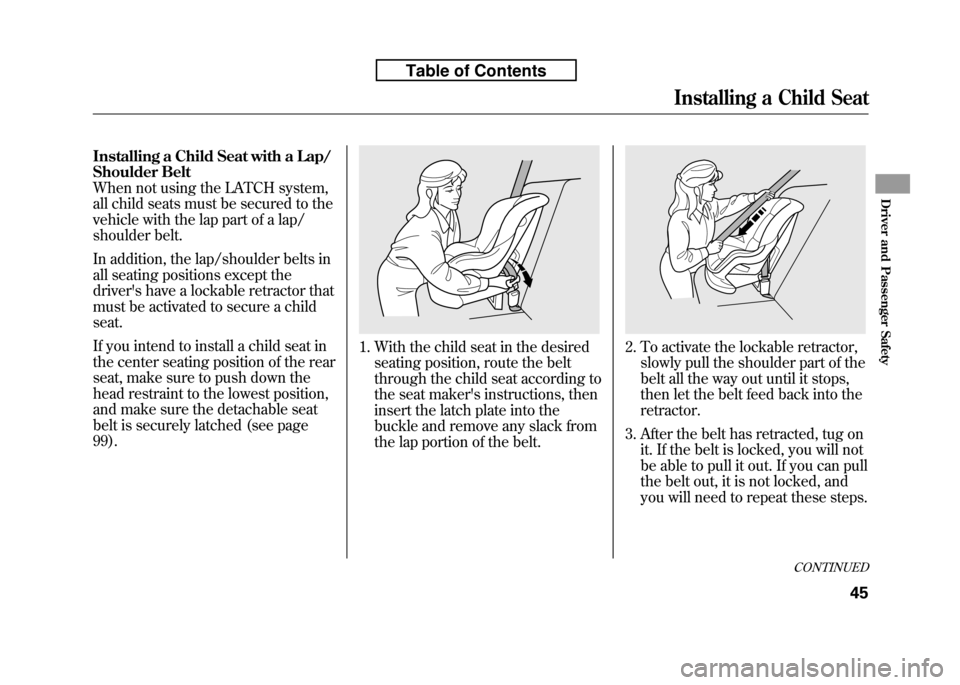
Installing a Child Seat with a Lap/
Shoulder Belt
When not using the LATCH system,
all child seats must be secured to the
vehicle with the lap part of a lap/
shoulder belt.
In addition, the lap/shoulder belts in
all seating positions except the
driver's have a lockable retractor that
must be activated to secure a childseat.
If you intend to install a child seat in
the center seating position of the rear
seat, make sure to push down the
head restraint to the lowest position,
and make sure the detachable seat
belt is securely latched (see page99).
1. With the child seat in the desiredseating position, route the belt
through the child seat according to
the seat maker's instructions, then
insert the latch plate into the
buckle and remove any slack from
the lap portion of the belt.2. To activate the lockable retractor,slowly pull the shoulder part of the
belt all the way out until it stops,
then let the belt feed back into theretractor.
3. After the belt has retracted, tug on it. If the belt is locked, you will not
be able to pull it out. If you can pull
the belt out, it is not locked, and
you will need to repeat these steps.
CONTINUED
Installing a Child Seat
45
Driver and Passenger Safety
Table of Contents
Page 66 of 351
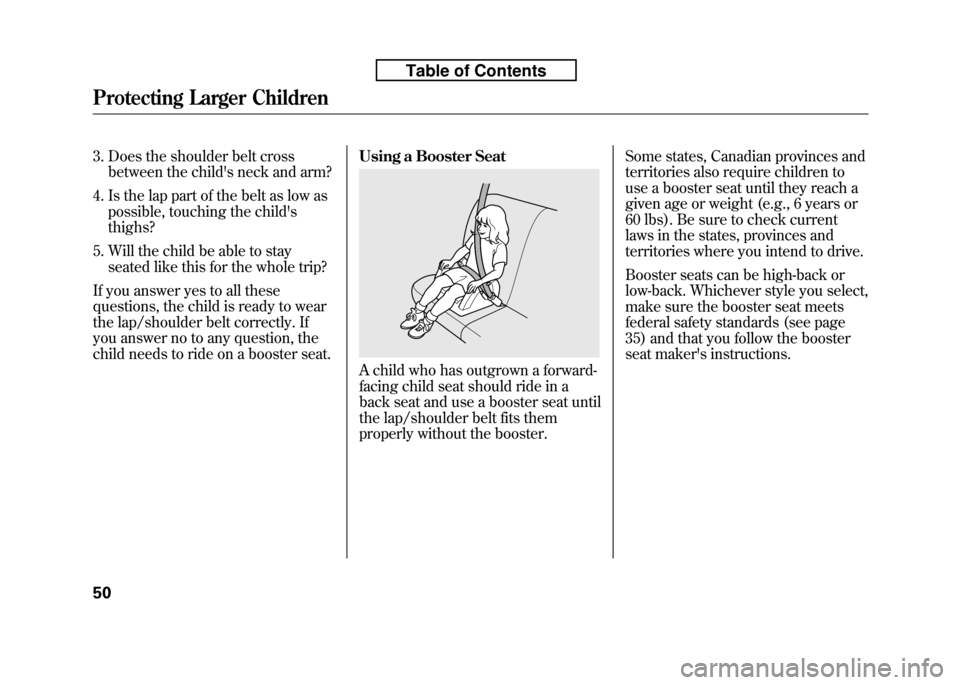
3. Does the shoulder belt crossbetween the child's neck and arm?
4. Is the lap part of the belt as low as possible, touching the child's thighs?
5. Will the child be able to stay seated like this for the whole trip?
If you answer yes to all these
questions, the child is ready to wear
the lap/shoulder belt correctly. If
you answer no to any question, the
child needs to ride on a booster seat. Using a Booster Seat
A child who has outgrown a forward-
facing child seat should ride in a
back seat and use a booster seat until
the lap/shoulder belt fits them
properly without the booster.Some states, Canadian provinces and
territories also require children to
use a booster seat until they reach a
given age or weight (e.g., 6 years or
60 lbs). Be sure to check current
laws in the states, provinces and
territories where you intend to drive.
Booster seats can be high-back or
low-back. Whichever style you select,
make sure the booster seat meets
federal safety standards (see page
35) and that you follow the booster
seat maker's instructions.
Protecting Larger Children
50
Table of Contents